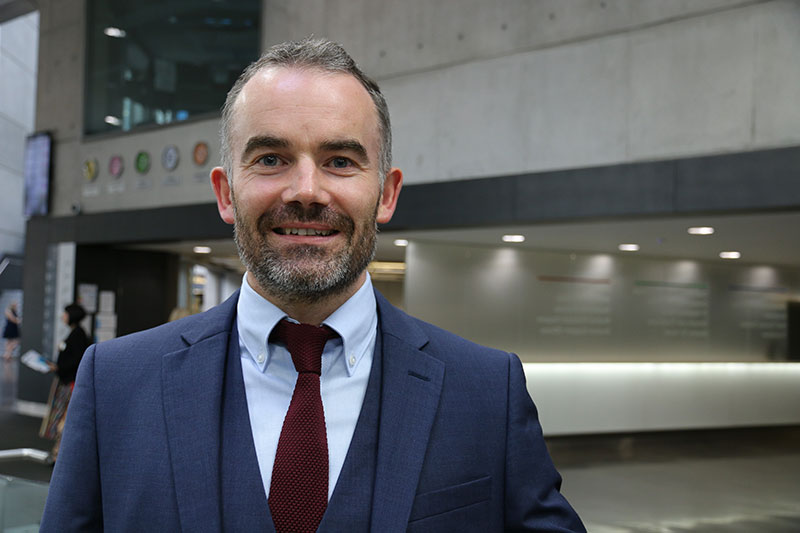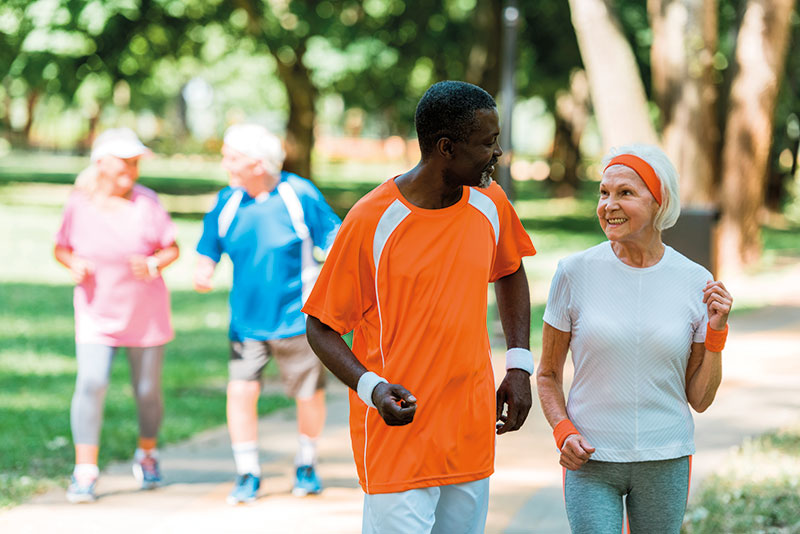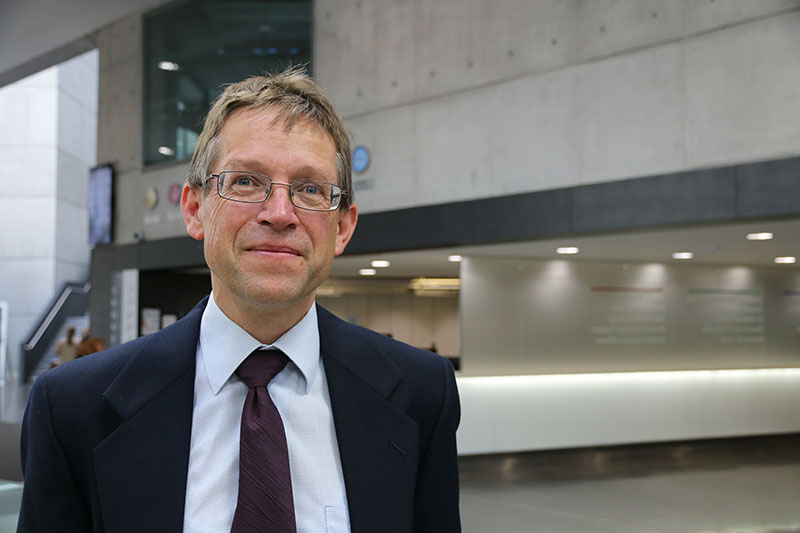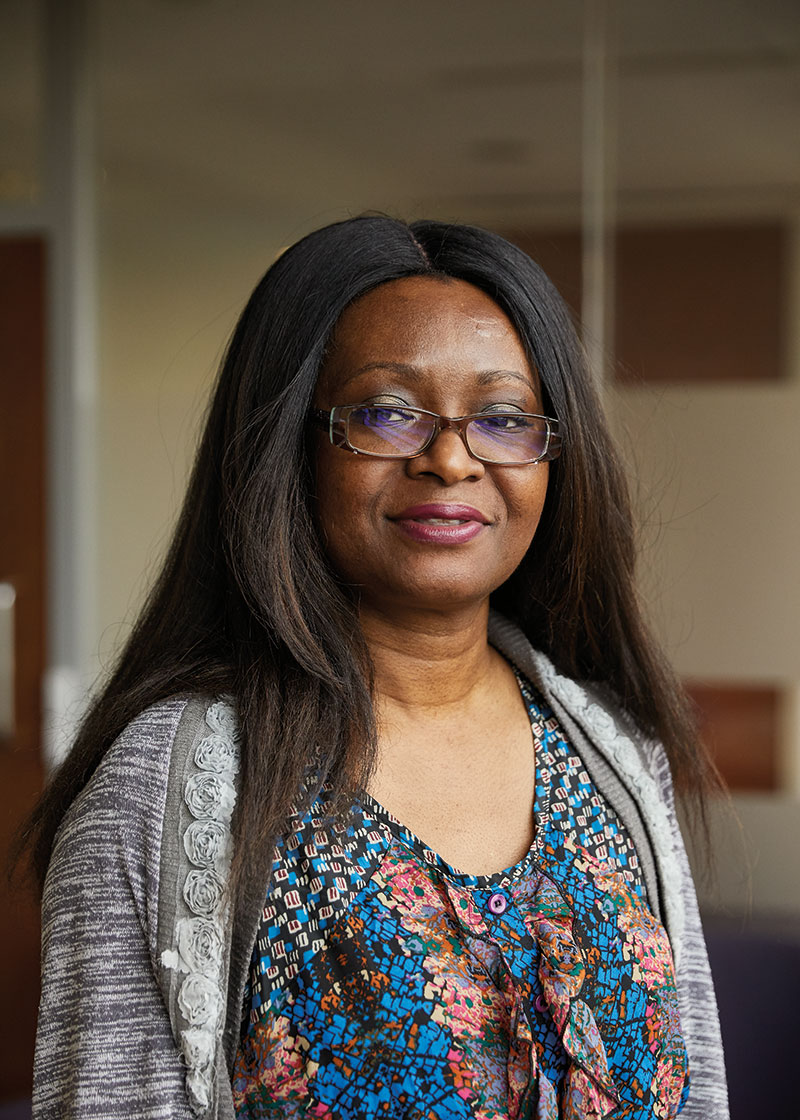Fitness for life
Whether it be swimming, running, yoga or just walking up the stairs, we all know about the benefits of exercise.
It has a positive impact on physical and mental health; it can raise energy levels and reduce the risk of major illness. The NHS website calls it “the miracle cure we’ve all been waiting for.”
Recommendations outline the need to do at least 30 minutes of exercise each day. It doesn’t sound like much. So why aren’t we all doing it?
We’ve all heard – and used – the excuses. I don’t have enough time; I’m too old; I don’t need to do that, I’m naturally fit.
Media channels are filled with a sometimes-confusing mix of advice. Social media influencers tell us what we should eat, sell us exercise routines, make themselves out to be experts.
But what are the facts?
Fitness and health experts at Manchester Metropolitan are doing ground-breaking work to bust some of the myths and help make the nation healthier.
It’s never too late

As we move into middle age, it is often easy to say, “it’s too late, I can never get fit now.” Therefore, we settle for what we have – and our health gradually declines.
But scientists at Manchester Metropolitan have discovered that people who start training later in life can have the same performance and health benefits as those who have trained all of their lives.
Researchers tested the performance, muscle and bone health of masters athletes, people aged 60-85 years old who continue to compete at a high level in sport. A group had been competitive endurance runners all of their lives and another group had only started training after the age of 50.
"Long-term endurance training not only reduces fat mass, but may also help to maintain larger muscles"
They found that by the age of around 70, physical fitness, sports performance and muscle health were equally as good in both athlete groups despite a 30-year difference in training history.
The results could inform decisions of practitioners and policy makers who are working with middle-aged people living in communities who are thinking of taking up exercise to boost their health or fitness, but are worried that it may be too late to reap the full benefits.
Professor Jamie McPhee, Head of the Department of Sport and Exercise Sciences, said: “It is important to understand whether the age at which people take up competitive endurance running influences muscle and bone health as well as body composition in later life, because these systems directly affect a person’s ability to live a full and active life in older age.
“Regular exercise is the best way to combat age-related declines of muscle and bone mass and to counter the slow but steady increase of body fat stores that affect most people in middle age. Before starting this research, we already knew that exercise is beneficial for health at any age, but we were not sure whether it was possible for people starting training after age 50 to catch up with those who trained regularly all of their lives.”
A total of 150 master endurance runners completed health and exercise performance tests, as the researchers also studied a group of 59 healthy non-athletic older adults for comparison.

The participants had X-ray scans to test bone mineral density and body composition – fat mass and muscle mass – while performance was determined by taking the athlete’s highest ranked performance within the last two years and comparing it as a percentage of the world record for that age and distance.
Muscle function was measured using a hand dynamometer to test grip strength and a platform to measure lower limb power when jumping. The results showed that both groups had 17 per cent lower body fat and 12 per cent greater leg muscle mass than the healthy non-athletic control group.
Professor McPhee added: “Our research shows that longterm endurance training not only reduces fat mass, but may also help to maintain larger muscles. This is important as it can enable people to maintain a healthy weight and stay more active and independent for longer into older age.
“The values for body composition and athletic performance of the late starters were very similar to those of people who had trained all of their adult lives. This shows that it is never too late to start regular, intense endurance running, or possibly any other sports training or competition at the highest level of masters sports, at, or after, the age of 50 years – there are great performance and health benefits to be had.
“The results should be considered by practitioners when recommending physical activity for older adults aiming to reduce fat mass, gain leg lean mass or improve bone mineral density.
“Policy makers should also consider endurance training as an alternative, or addition, to resistance exercise to combat the steady loss of muscle mass and strength that occurs with ageing, known as sarcopenia – a disease associated with the loss of muscle mass, strength and function related to ageing.”
Power V Endurance

It’s a perennial argument. Do you get fit by lifting weights or by doing cardiovascular exercise? Some people will argue they can’t do both – that building strength means they have to focus on resistance exercise, or that they will lose their stamina and endurance if they focus on how much weight they can bench press.
But Manchester Metropolitan researchers have shown athletes do not have to sacrifice power to improve their endurance and viceversa, helping bust the myth that there has to be a ‘trade off’ between the two.
Research by physiology experts has shown the idea that strength or tolerance will diminish if an athlete invests training time to build up the other is misguided.
The study, carried out in collaboration with the Lithuanian Sports University (LSU) in Kaunas, Lithuania, suggests a mix of exercise of moderate intensity and long duration (endurance exercise) with exercise of high-intensity but short duration (resistance exercise), known as combination training, works best.
In fact, the study shows that team athletes who enjoy a blend of power and endurance training had as good a performance as endurance athletes in aerobic tests and as good a performance as power athletes in muscle strength tests.
"The common assumption is that building either endurance or power, you will diminish the other. But our study shows the trade-off between the two is probably not there"
The research team recommended power athletes introduce endurance training and endurance athletes adopt power training, adding that any endurance exercise such as cycling, running or swimming is particularly beneficial for all-round fitness.
For non-athletes, the team advised stair climbing, jogging and even vigorous housework as alternatives to gyms and indoor exercises that may require specific equipment and motor skills.
Lead academic Hans Degens, Professor of Muscle Physiology at Manchester Metropolitan, said: “The common assumption is that building either endurance or power, you will diminish the other. But our study shows the trade-off between the two is probably not there.”
The joint Manchester Metropolitan and LSU team compared the performance in a number of controlled exercises of endurance athletes (distance runners, road cyclists, paddlers and skiers), power athletes (sprinters, throwers, combat sport athletes and bodybuilders), team athletes (basketball, football and volleyball players) and non-athletes.
The athletes in the large-scale study performed at a recreational to elite level of competition, and trained between three and 14 times a week.

Among multiple other tests such as completing countermovement vertical jumps – jumping from a standing start – and measurements such as body composition, participants were also asked to perform an incremental running test while the researchers measured their VO2max – the maximum amount of oxygen a person can utilise during intense exercise, and a measure of someone’s aerobic endurance.
The researchers also tested the participants’ muscle strength and stroke volume – the amount of blood pumped by the heart per beat – with techniques called dynamometry and M-mode echocardiography respectively.
They found team athletes had a similar VO2max to endurance athletes and a similar jump power to power athletes, suggesting that superimposing regular resistance training to an endurance programme will not reduce performance in power events at the expense of endurance and vice versa.
Professor Degens said: “Our study shows team athletes actually have the best of both and that is a fantastic observation. We did not expect to find that.
“It demonstrates that endurance training for power athletes and power training for endurance athletes is not detrimental.”
Explaining why the two training regimes may complement each other and improve overall performance, Professor Degens said: “In physiological terms, if you are doing any physical activity then you need to employ a certain amount of muscle for a movement.
“But if you can recruit a smaller proportion of that muscle to do exactly the same amount of work then you can delay the onset of fatigue – or you can perform the movement at a higher speed.”
Professor Degens said the findings of the study would be of interest to anyone undertaking or thinking of undertaking any kind of fitness or sport. He said: “You could apply this to everyone, not just athletes, as we think it’s better for your health overall, although that was not something considered in our study. “If you’re a very slender person who is more suited to endurance, or a very stocky person more suited to power, it won’t harm to introduce exercises of the other type.”
Influencing Policy

It is often assumed that going to a gym on a daily basis is the best thing for keeping fit and strong as we get older.
But pounding the treadmill or pumping weights might not be as beneficial as first thought.
Research by Dr Gladys Pearson, Deputy Director of the Musculoskeletal Science and Sports Medicine Research Centre at Manchester Metropolitan, has revealed that older people who keep regularly moving are more likely to have better bone health than those who carry out just one bout of high-intensity exercise a day.
"This research is a real positive for people over 60 years old"
The study, which looked into the impact of older people’s physical behaviour and daily activities on their bone health, found that it is better for elderly people to limit their sitting time by getting up to do something as simple as make a cup of tea several times a day – rather than carry out a single short bout of intensive weight-bearing activity.
Dr Pearson said: “Research suggests that sitting for long periods of time reverses the effect of exercise. “The government recommends 150 minutes of exercise a week, but we now realise that if the rest of your day is spent in a sedentary state then this will have limited benefits and could cause issues for bone health of the elderly.
“Elderly people who get up often throughout the day, whether just to make a cup of tea, walk up the stairs, or take a short walk, are more likely to have better bone health than those that spend a lot of time sitting, regardless if they have been to a gym class that day.”
After leaving a monitoring device on the leg of 112 elderly people – measuring all movements, the intensity of movements and sitting and sleeping behaviour – results showed that men who got up from their chair more throughout the day tended to have a higher bone mineral density than those who sat a lot. Moderate-intensity exercise, such as brisk walking or gardening, was also seen to be beneficial to men’s bone health.
In women, a slight difference was seen compared to men, in terms of what is the optimal pattern of physical behaviour – light-intensity workouts such as casual walking, doing household chores or activities of daily living, were more beneficial for their bone health than moderate-intensity exercise.
Both benefited from sitting less and moving more.

Dr Pearson added: “This research is a real positive for people over 60 years old. It just shows that if you are not a ‘gym bunny’, you can still maintain good bone health through light-intensity exercise – the key message is just to not sit down for so long in a day.
“We hope that this encourages older people to get up more.”
The research has now been cited in new government guidelines on the amount and type of physical activity people should be doing.
A new report, compiled by UK Chief Medical Officers, offers updated advice to the public on what they ought to be doing to improve their health, such as sport, types of movement and decreasing sedentary activities.
The report says that Dr Pearson’s research “supports the benefits of being active throughout the day, such as better maintenance of bone health with higher volumes of light intensity activity spread throughout the day”.
The new guidelines overturn previous recommendations that physical activity needed to last at least 10 minutes to bring benefits. The updated advice means that even a quick sprint up the stairs can contribute to the 150 minutes of moderate to brisk exercise that adults are recommend to undertake every week.
